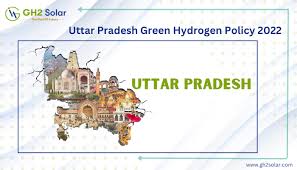X : @the_news_21
The Yogi Adityanath-led Uttar Pradesh government has been making consistent and collective efforts to promote sustainable energy solutions with a view towards achieving India’s net zero goal. Taking a step further in this direction, the state government recently approved the Green Hydrogen Policy, rolling out a series of administrative and financial incentives to promote green hydrogen and ammonia production, market creation, and demand aggregation. The incentives are being pushed through the UP-Government’s investment arm UP Invest.
Green Hydrogen and ammonia are produced by the electrolysis of water using renewable energy. They are expected to serve as a cleaner and more sustainable alternative to fossil fuels and are likely to play a pivotal role in facilitating India’s transition to the net zero goal by 2070. Green Hydrogen has a large potential uptake from nitrogenous fertilisers, chemicals, refineries, heavy-duty vehicles, energy storage, and the iron and steel sectors.
Chemicals and fertilisers contribute to nearly 50 per cent of UP’s industrial emissions, and refineries add another 5 per cent. Therefore, the Uttar Pradesh Green Hydrogen Policy 2022 focuses on two major demand centers: nitrogenous fertilisers and petrochemical refineries. Promoting green Hydrogen and ammonia in these sectors will help address more than 50 per cent of the State’s industrial emissions. However, it is also likely to cover other emerging industries and applications of green Hydrogen in the future.

The current hydrogen demand in the State stands at around 0.9 million tonnes per annum (Mtpa). It is primarily used in Nitrogen-based fertilisers, with some demand coming from the refinery sector. By implementing this policy, the state government plans to be a leading green hydrogen and ammonia producer and a 100 per cent consuming state by 2035. It intends to achieve this status by pushing for 20 percent green Hydrogen blending by 2028 for existing fertiliser and refinery units and gradually reaching 100 per cent by 2035.
The state government’s policy is in line with the central government’s National Green Hydrogen Mission, which has estimated an initial outlay of Rs 19,744 crore. This includes Rs 17,490 crore for the SIGHT (Strategic Interventions for Green Hydrogen Transition) program, Rs 1,466 crore for pilot projects, Rs 400 crores for R & D, and Rs 388 crore for other mission components.
Incentives and subsidies rolled out.
The UP government prioritised decarbonisation while aligning with India’s climate goals. It has rolled out various incentives and subsidies as a part of the Green Hydrogen Policy to attract manufacturers to set up green hydrogen hubs in the State. While on the one hand, the state government’s move is expected to bring in a host of investments in the space of clean energy, on the other hand, it is likely to promote a spurt in growth and employment in the State, thereby helping it achieve the vision of turning into the country’s third-largest economy up from the current position of fifth in the next few years.
The policy, which is set to boost the manufacturing ecosystem, lead R & D and innovation activities, and provides incentives for promoting green Hydrogen adoption, among other things, is expected to support production, consumption, market creation, and other elements across the green Hydrogen and ammonia value chain.

Several states, including Andhra Pradesh, Maharashtra, Gujarat, Tamil Nadu, and Odisha, have either rolled out a separate green Hydrogen policy or included it as part of their renewable energy policy. Some states have also signed MoUs with large corporate companies to ramp up production of green Hydrogen. To facilitate investments in the sector, the UP government has rolled out a host of incentives and subsidies, such as stamp duty exemption, tax reimbursement, capital interest subsidy, and infrastructure interest subsidy, among others. The state government has already put in place a single-window clearance platform, which is expected to support new investment projects in the sector.
Apart from these initiatives, the state government also plans to develop green Hydrogen and ammonia industrial clusters or hubs to promote their production around consumption centres and provide government land to set up such units on a priority basis. As green Hydrogen is required to be produced using renewable energy, the state government plans to deploy solar power plants for its production.
It is to be noted that Uttar Pradesh has set a vision of meeting 40 per cent of its energy requirement through solar and alternative sources. The Green Hydrogen Policy approved by the state government will help spur investments into the segment and push for the production of alternate energy sources. Uttar Pradesh, which aims to grow its economy to $1 trillion in the next few years, expects to become the country’s growth engine. Therefore, prioritising decarbonisation and contributing to the country’s climate goals would be a crucial step in this direction.



obviously like your website but you need to test the spelling on quite a few of your posts Several of them are rife with spelling problems and I to find it very troublesome to inform the reality on the other hand Ill certainly come back again
buy clomiphene tablets how to get cheap clomiphene tablets can i order generic clomid without insurance cost generic clomiphene online how to buy generic clomiphene price buy clomid without prescription can i purchase generic clomid online
This is the description of glad I get high on reading.
Thanks recompense sharing. It’s top quality.
buy zithromax no prescription – ofloxacin pills buy flagyl 200mg for sale
semaglutide uk – brand rybelsus 14mg buy periactin online cheap
generic motilium – sumycin pill cyclobenzaprine 15mg brand
order augmentin 625mg online – atbioinfo buy ampicillin generic
buy esomeprazole pills – nexiumtous nexium where to buy
generic coumadin 5mg – https://coumamide.com/ order cozaar 50mg pills
meloxicam price – relieve pain meloxicam cost
buy deltasone 40mg pills – adrenal prednisone 40mg cheap
generic amoxil – https://combamoxi.com/ buy amoxicillin online
buy diflucan medication – https://gpdifluca.com/# buy fluconazole 100mg sale
lexapro 10mg pills – anxiety pro buy escitalopram 20mg for sale
order cenforce 100mg without prescription – https://cenforcers.com/ order cenforce 100mg
cialis free samples – on this site cialis covered by insurance
take cialis the correct way – https://strongtadafl.com/# cheap cialis 5mg
ranitidine 150mg ca – https://aranitidine.com/# zantac 150mg generic
buy cialis and viagra – how much does 50 mg viagra cost 100mg viagra pills
The sagacity in this ruined is exceptional. https://gnolvade.com/
The sagacity in this ruined is exceptional. https://buyfastonl.com/amoxicillin.html
This is the kind of enter I recoup helpful. https://ursxdol.com/azithromycin-pill-online/
More articles like this would pretence of the blogosphere richer. https://prohnrg.com/product/metoprolol-25-mg-tablets/
The reconditeness in this serving is exceptional. cialis gГ©nГ©rique prix
The vividness in this ruined is exceptional. https://ondactone.com/simvastatin/
The thoroughness in this break down is noteworthy.
https://doxycyclinege.com/pro/spironolactone/
This is the make of enter I find helpful. http://web.symbol.rs/forum/member.php?action=profile&uid=1171354
dapagliflozin order – https://janozin.com/# dapagliflozin order
buy xenical generic – orlistat order online buy xenical sale
With thanks. Loads of expertise! https://sportavesti.ru/forums/users/izfna-2/
You can conserve yourself and your ancestors nearby being alert when buying medicine online. Some pharmaceutics websites function legally and sell convenience, reclusion, sell for savings and safeguards over the extent of purchasing medicines. buy in TerbinaPharmacy https://terbinafines.com/product/crestor.html crestor
With thanks. Loads of conception! TerbinaPharmacy
Thanks on putting this up. It’s okay done.
Tham gia cộng đồng game thủ tại Go88 để trải nghiệm các trò chơi bài, poker phổ biến nhất hiện nay.